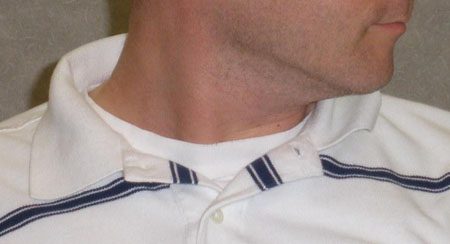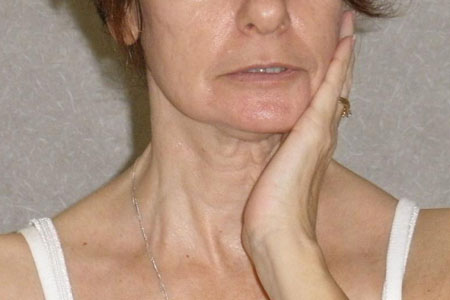Approach
Acquired cervical dystonia is diagnosed clinically, but appropriate treatment is often delayed due to a lack of clinical recognition. The key to diagnosis is an appropriate clinical suspicion for the disorder, coupled with a sensitive history and physical examination.
History
The presentation of a patient may include the following features:
Involuntary twisting or deviation of the neck: may be verbalised as a cramp or spasm in the neck, shoulder, or upper back
Pain: present to some degree in most cases, may be the chief presenting complaint, and severe enough to be a source of disability in a significant minority of cases[15]
Head tremor: may also be the chief complaint
Insidious onset of symptoms: a sudden onset of symptoms would raise suspicion of a secondary acquired torticollis, or another disorder entirely
Ability to identify a primary direction for involuntary head movement; for example, twisting to the left and tilting backwards
Chiropractic intervention: many patients initially seek this.
[Figure caption and citation for the preceding image starts]: Patient with moderate left torticollis or neck rotation, mild right laterocollis or lateral neck flexion, and mild retrocollis or neck extensionFrom the collection of Dr David Sommer [Citation ends]. [Figure caption and citation for the preceding image starts]: Patient with severe left torticollis (note hypertrophy of right sternocleidomastoid muscle)From the collection of Dr David Sommer [Citation ends].
[Figure caption and citation for the preceding image starts]: Patient with severe left torticollis (note hypertrophy of right sternocleidomastoid muscle)From the collection of Dr David Sommer [Citation ends].
An important alleviating factor is the presence of a sensory trick (geste antagoniste), defined as a movement the patient performs (usually to touch himself or herself in some way) that can ameliorate the involuntary movement and pain.
Sensory tricks usually involve bringing the hand to the face
The trick generally must be performed by the patient (as opposed to examiner) to be effective and can sometimes be effective even before the hand reaches the face
In some cases, just thinking about the sensory trick can provide relief
There is no significant association between direction of primary dystonic posture and laterality of hand used to perform the sensory trick. Other sensory tricks include resting the back of the head or neck on an object[16]
The absence of a sensory trick by no means rules out the diagnosis, but its presence greatly increases the likelihood of diagnosis, as this is a common and specific feature.[17]
[Figure caption and citation for the preceding image starts]: Patient using sensory trick with reduction in dystonia severityFrom the collection of Dr David Sommer [Citation ends].
Most cases of acquired torticollis are idiopathic. However, certain factors have a weak association with the diagnosis, including a positive family history, trauma, and a history of the use of dopamine-blocking drugs. In order to identify the possible risk factors, suggested lines of enquiry for the practitioner in the history-taking process include:
Prompting the patient with signs and symptoms of subtle or alternative presentations that may help with eliciting a significant family history; for example, a history of chiropractic therapy to the neck area or involuntary head movements
Enquiring about a history of trauma. This may identify a potential inciting factor or be important in considering alternative aetiologies
Enquiring about a history of exposure to dopamine-blocking drugs (e.g., metoclopramide, antiemetics and antipsychotics). This raises the possibility of drug-induced dystonia.
Physical examination
During physical examination, the degree of abnormal head posture (torticollis or neck rotation, anterocollis or neck flexion, retrocollis or neck extension, laterocollis or lateral neck flexion, or lateral shift) is observed and recorded (with and without the use of a sensory trick).
It is important that the patient is relaxed, as this may allow the primary abnormal posture to emerge. This can be assisted by:
Having patients walk or asking them to perform rapid alternating movements with their hands
Asking patients to close their eyes.
The continuous use of compensatory manoeuvres to avert involuntary movement can create the appearance of a tremor.[1] The head tremor consists of opposing dystonic and compensatory movements/manoeuvres. Features that differentiate it from essential tremor of the head include:
A typically asymmetrical pattern
Irregularity or jerky quality.
Examination of the neck includes:
Palpation of neck musculature: may reveal hypertrophy of muscles involved in the dystonic posture. Focal tenderness is unusual and would raise suspicion of an alternative aetiology.
Passive range of motion (ROM) in the neck: should be normal in early and mild cases.
Neurological examination should include an assessment of:
Mentation
Cranial nerves
Strength and tone in the neck and all extremities
Sensation
Reflexes
Co-ordination
Gait.
These parameters are typically normal. Observed neurological abnormalities should raise a suspicion of secondary acquired torticollis or an alternative aetiology of dystonia. There are multiple clinical rating scales for cervical dystonia. The Toronto Western Spasmodic Torticollis Rating Scale (TWSTRS) is the most frequently used, and may be helpful in guiding the clinician through a thorough examination.
Further investigations
In typical cases, no further work-up beyond a history and physical examination is indicated, as ancillary studies are almost always normal.[18]
If the presentation is atypical, or additional abnormalities are discovered on neurological examination, computed tomography (CT) or magnetic resonance imaging (MRI) of the brain and/or neck (depending on abnormalities discovered) may be indicated
If cervical injury is suspected, testing for ROM is deferred and appropriate immobilisation established
A CT or MRI of the neck should be considered in patients with prominent pain complaints, reduced ROM of the neck, a visible or palpable mass, severe focal tenderness, or radiculopathy
Electrophysiological studies, such as electromyography, are not typically indicated. However, they may be useful in guiding treatment with botulinum toxin
Laboratory tests are generally not necessary but may be indicated if alternative/secondary diagnoses are being considered (e.g., Wilson's disease, Huntington's disease). In patients under 30 years of age, genetic testing for primary torsion dystonia (DYT-1) and screening tests for Wilson's disease (serum copper, ceruloplasmin and urinary copper excretion) may be appropriate. The European Federation of Neurological Societies recommends DYT1 testing before 30 years of age for patients with primary dystonia with limb onset, and in those with an affected relative with early-onset dystonia. DYT6 testing is recommended in early-onset or familial cases with craniocervical dystonia or after exclusion of DYT1. Individuals with early-onset myoclonus should be tested for mutations in the DYT11 gene.[18]
Consultation
A diagnosis of acquired torticollis should prompt referral to a specialist. Ideally, patients are referred to a movement disorders specialist. Referral to a neurologist or physiatrist is also appropriate from the primary care setting.[18] If botulinum toxin injections or other interventions are being considered, a consultant with experience in the intervention of interest should be sought.
Use of this content is subject to our disclaimer